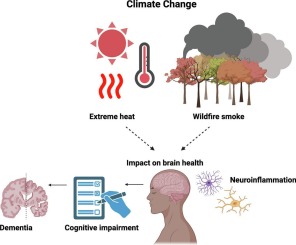
**The Concealed Effects of Wildfire Smoke: How Residing in Fire-Affected Regions Can Diminish Life Span**
Wildfires are increasingly emerging as both a frequent and destructive phenomenon in numerous areas, especially throughout the contiguous United States. Apart from the immediate devastation wrought by flames, researchers are revealing troubling data that indicate wildfire smoke represents a long-term danger to public health, potentially shortening life expectancy. This week’s annual **American Geophysical Union (AGU)** meeting highlighted these discoveries, showcasing alarming new research on the cumulative impacts of smoke exposure on human life span.
### The Consequences of Wildfire Smoke on Life Span
The research, spearheaded by environmental and public health scholars, shows that each extra day of wildfire smoke exposure could decrease life expectancy by about 0.02 years—or roughly one week. These conclusions were drawn from an extensive review of over 66,000 records from U.S. census data between 2010 and 2015, providing critical insights into how smoke pollution relates to a range of sociodemographic and environmental elements influencing health results.
Wildfire smoke contains fine particulate matter (PM2.5), a hazardous pollutant that can penetrate deep into the lungs and bloodstream. Continuous exposure to PM2.5 has been associated with various chronic health conditions, including cardiovascular and respiratory diseases, which play a role in lowering life expectancy.
**“This work aims to elevate awareness regarding the health implications of wildfires,”** noted Cao, a co-author of the research. **“In order to achieve this, we must improve risk communication with the public and bolster research into the impacts of these calamities.”**
### Disparities in Exposure and Vulnerability
While the study underscores the general health dangers posed by wildfire smoke, it also highlights important inequities in how these risks are distributed. Individuals from higher-income backgrounds generally enjoy better living conditions, nutrition, and healthcare, which can lessen the detrimental effects of smoke exposure. In contrast, minority communities and those with lower socioeconomic status often encounter compounded challenges, such as residing in regions with heightened pollution levels, reduced access to healthcare, and insufficient resources to tackle environmental threats.
**“Families with more disposable income tend to have better living conditions, enhanced nutritional intake, and cleaner surroundings,”** Cao elaborated, emphasizing the need to tackle systemic inequality in public health strategies.
### A Natural Mitigation: The Importance of Greenspaces
Interestingly, the study revealed that the availability of greenspaces—parks, forests, and vegetation—can have a beneficial impact on life expectancy. A mere 1% rise in greenspace was linked to observable improvements in longevity. However, this advantage could be mitigated if greenspaces are situated in areas vulnerable to wildfire smoke, highlighting the necessity for holistic urban planning that integrates both environmental and public health considerations.
**“Residents in areas with ample greenspaces should carefully evaluate suitable health protection measures if they face wildfire smoke exposure,”** stated Jianyong Wu, an assistant professor of environmental health sciences at Ohio State University and a co-author of the research.
### Consequences for Urban Planning and Governance
This research adds to the growing comprehension of how environmental factors affect public health. It emphasizes the pressing need for lawmakers, urban planners, and public health authorities to confront the escalating risks linked to wildfires and air pollution. Strategies to mitigate the impacts of wildfire smoke might include:
1. Broadening access to air quality monitoring resources and public health notifications.
2. Formulating policies to enhance air filtration systems in homes, educational institutions, and workplaces.
3. Increasing funding for greenspaces while factoring in wildfire risk during their design and location.
4. Tackling systemic disparities to guarantee that at-risk populations have access to protective measures and resources.
**“Our aim is for this research to provide meaningful guidance for future urban planning and public health policies designed to enhance life expectancy nationwide,”** Wu stressed.
### Broadening the Research Scope
Although this study concentrated on data throughout the United States, researchers intend to investigate regional disparities concerning the health impacts of wildfires further. Upcoming studies might consider whether places like Ohio—which regularly face other environmental challenges, like drought—experience comparable shifts in adult and child mortality stemming from wildfire smoke and associated issues.
### Promoting Awareness and Fostering Resilience
As wildfires become more frequent and severe due to climate change, comprehending their effects on public health becomes crucial for countering their long-term impacts. By illuminating the link between smoke exposure and life span, this research aspires to encourage broader awareness and proactive measures.
Ultimately, the study advocates for prioritizing public health amid the rising prevalence of environmental catastrophes. Whether through smarter urban design, targeted health responses, or advocacy for at-risk communities, there is little time left to address the extensive effects of wildfire smoke.
As Wu succinctly stated, **“Our findings enhance the understanding of how environmental elements influence public health.”**